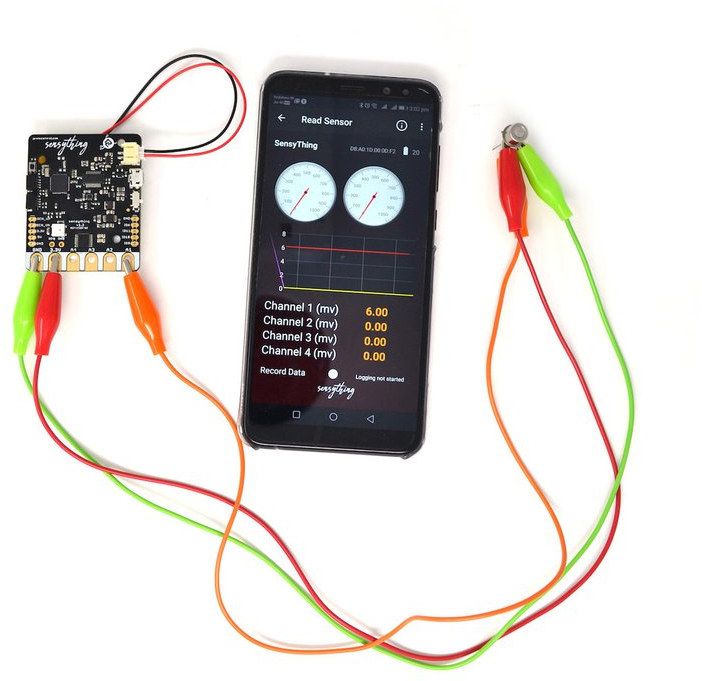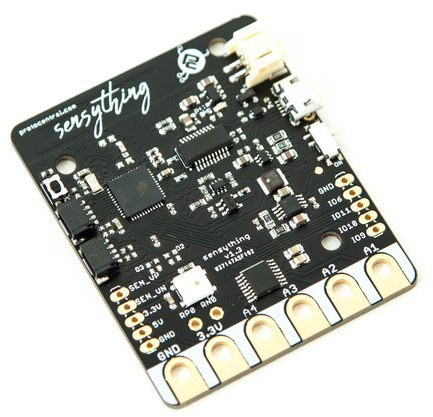We’ve previously covered to health related boards from Protocentral with HealthPi Raspberry Pi HAT measuring vitals signs, and HeartyPatch open source ECG patch powered by an ESP32 WiSoC.
Today, I’ll write about another of their board – Sensything -, not directly related to health applications, but designed for multiple sensor’s analog and digital (I2C, GPIO) data acquisition, and designed around Espressif Systems ESP32 WiFi & Bluetooth SoC.
Sensything specifications:
- SiP- Espressif Systems ESP32-PICO-D4 system-in-package with 4MB Flash, Texas Instruments ADS1220 ADC
- Wireless Connectivity
- 2.4 GHz WiFi with on-board PCB antenna, support for Station and Access Point (AP) modes
- Bluetooth 4.2 / Bluetooth Low Energy (BLE)
- USB – 1x micro USB port with FT230X (USB-CDC)
- Expansion I/O:
- Board-edge alligator clip compatible analog input connectors
- 2x Sparkfun Qwiic-compatible I2C ports
- 4x general-purpose I/O pins
- Analog Input details
- 4 channels single-ended, 2-channel fully differential
- Full-scale input range: ± 2.048 V to ± 0.016 V (adjustable gain)
- Sampling rate: 20 samples/second (SPS) to 2000 SPS
- Current sources: On-board excitation current sources adjustable from 10 uA to 1500 uA
- Built-in 2.048 V voltage reference with 5 ppm/°C drift
- Built-in temperature sensor with 0.5°C accuracy
- Misc – 1x WS2812 RGB user-controllable LED
- Power Supply:
- Li-ion battery (3.7 V, 1000 mAh) with on-board USB battery charger
- 5V DC/DC boost converter with low-noise LDO for analog power
- 3.3 V digital supply voltage
- Dimensions – 47×57 mm; height: 5 mm (board only), 12 mm with included battery stacked
 The board support three operating modes:
The board support three operating modes:
- Simple Acquisition Through BLE – The default (pre-loaded) program reads all four channels of the ADC and sends data through BLE to an Android app as shown in the photo above.
- Wi-Fi Access Point Mode – Using another firmware, you can configure the board to as an access point, as access sensor data over a Web interface accessible from your local network (no cloud or internet connection involved).
- Developer mode – You can write programs with the Arduino IDE or using the ESP-IDF, and upload the resulting binary through the on-board USB-UART chip.
The board will apparently be open source, but I can’t find anything yet about Sensything on ProtoCentral’s github account. They did release hardware and firmware for their previous two boards however, so that’s probably just a question of time.
Sensything board launched on Crowd Supply a little while ago, and pledges start at $49 for an early-bird board without battery, nor cables, but if you’d like a readyto-use kit, then the Basic Kit with Sensything board, a 1,000 mAH LiPo battery, then 2-ended alligator clip leads , and microUSB cable for charging and programming is offered for $75. You’d still need your own sensor though. Shipping is free to the US, and $15 to the rest of the world. You should expect your reward around the end of November, and while ProtoCentral is based in India, all boards and kits will ship from Crowd Supply’s headquarters in the US.

Jean-Luc started CNX Software in 2010 as a part-time endeavor, before quitting his job as a software engineering manager, and starting to write daily news, and reviews full time later in 2011.
Support CNX Software! Donate via cryptocurrencies, become a Patron on Patreon, or purchase goods on Amazon or Aliexpress. We also use affiliate links in articles to earn commissions if you make a purchase after clicking on those links.






I think one important information is the power consumption in different modes (for example: deep-sleep), the design is very important here. I didn’t found any information about this (ESP32 goes down to 0.005 mA in deep sleep mode (I proofed it with ESP-WROOM-32 module), many boards need 10 mA due bad low-power design). Do you have any information about this?
Answer:
https://www.cnx-software.com/wp-content/uploads/2018/10/ESP32-Silicon-Labs-Power-Profiler.jpg
https://www.cnx-software.com/wp-content/uploads/2018/10/Sensything-deepsleep-Power-Profiler.jpg